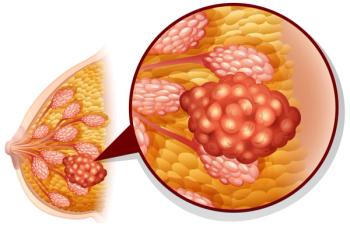
Durvalumab Plus Tremelimumab Fails to Meet Survival End Point in Phase 3 Metastatic NSCLC Study
The phase 3 NEPTUNE study indicated that durvalumab plus tremelimumab did not reach an amended primary end point of improved overall survival among patients with metastatic non–small cell lung cancer with a blood tumor mutational burden of at least 20 mut/Mb, though the combination did yield a numerical reduction in risk of death.
First-line durvalumab (Imfinzi) and tremelimumab (Imjudo) did not achieve a statistically significant improvement in overall survival (OS) vs standard chemotherapy among patients with metastatic non–small cell lung cancer (NSCLC) and a blood tumor mutational burden (bTMB) of 20 mut/Mb or more, according to findings from the open-label phase 3 NEPTUNE trial (NCT02542293).
Among the evaluable population, durvalumab and tremelimumab did not yield a statistically significant improvement in OS compared with standard chemotherapy, although the combination reduced the risk of death with an HR of 0.71 (95% CI, 0.49-1.05; P = .081). The median OS was 11.7 months (95% CI, 8.6-15.2) for the durvalumab/tremelimumab arm and 9.1 months (95% CI, 7.8-12.6) for the chemotherapy arm.
The 24-month OS rates for patients in the durvalumab plus tremelimumab arm and chemotherapy arm, respectively, were 26.1% (95% CI, 16.4%-36.8%) and 13.6% (95% CI, 6.4%-23.6%). Additionally, the HR for progression-free survival (PFS) was 0.77 (95% CI, 0.51-1.15), and the median PFS for the combination and chemotherapy cohorts, respectively, was 4.2 months (95% CI, 2.7-5.6) vs 5.1 months (95% CI, 4.2-5.6).
A total of 823 enrolled patients were randomly assigned 1:1 to either durvalumab plus tremelimumab (n = 410) or chemotherapy (n = 413). Patients in the experimental arm received 20 mg/kg of durvalumab every 4 weeks until disease progression along with 1 mg/kg of tremelimumab every 4 weeks for up to 4 treatment cycles. Those in the control arm received an investigator’s choice of platinum-based chemotherapy every 3 weeks for 4 to 6 cycles.
A total of 512 patients were evaluable for bTMB, including 129 patients with bTMB of 20 mut/Mb or more; this population included 69 patients in the durvalumab plus tremelimumab cohort and 60 in the standard chemotherapy cohort.
Adults with stage IV NSCLC were eligible to participate in the study if they had no previous systemic therapy for advanced NSCLC. Additional inclusion criteria included an ECOG performance status of 0 or 1, measurable disease per RECIST v1.1 criteria, and confirmed PD-L1 expression prior to treatment randomization.
The amended primary end point of the trial was OS among patients with a bTMB of 20 mut/Mb or more. Key secondary end points included PFS in patients with a bTMB of 20 mut/Mb or more and safety among all study participants.
The median age of all patients in the intent-to-treat (ITT) population was 64 years (range, 27-90). Although the study investigators reported a balanced profile of baseline characteristics in the ITT population, there were imbalances observed within the bTMB of 20 mut/Mb or more population that impacted efficacy analyses. This included race, ECOG performance status, tumor histology, PD-L1 expression, smoking status, and number of target lesions.
In a post-hoc analysis adjusting for the number of target lesions among patients in the bTMB of 20 mut/Mb or more population, investigators reported an improved OS HR of 0.65 (95% CI, 0.44-0.96). No further OS improvement was observed in the combination arm vs the chemotherapy arm in those with a bTMB of less than 20 mut/Mb, according to investigators.
For the overall safety population, the incidence of grade 3 or 4 treatment-related adverse effects (TRAEs) was 20.7% for the durvalumab plus tremelimumab arm and 33.6% for the chemotherapy cohort. In terms of notable immune-mediated AEs (imAEs), pneumonitis of any grade was observed in 5.9% of those receiving durvalumab plus tremelimumab and 0.3% of those receiving chemotherapy. Additionally, any-grade colitis was reported in 2.2% of the durvalumab plus tremelimumab cohort; there were no instances of colitis observed in the chemotherapy arm. Overall, safety results in the bTMB 20 mut/Mb or less analysis group were consistent with the ITT population.
Reference
de Castro G, Rizvi NA, Schmid P, et al. NEPTUNE: Phase III study of first-line durvalumab plus tremelimumab in patients with metastatic NSCLC. J Thoracic Oncol. 2022;18(1):P106-119. doi:10.1016/j.jtho.2022.09.223
Newsletter
Stay up to date on recent advances in the multidisciplinary approach to cancer.





